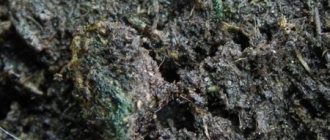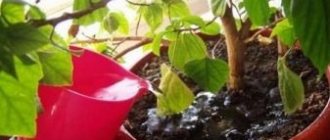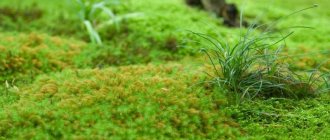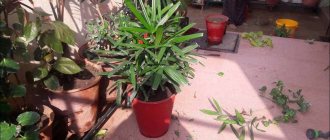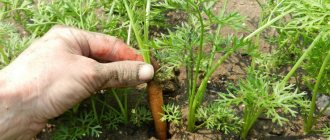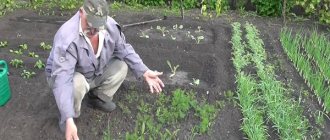Air does not circulate
There is a fence around the perimeter of the dacha area, trees or shrubs are densely planted - factors that reduce ventilation. In a greenhouse, the effect is multiplied if you do not ventilate it periodically. This leads to water retention and the soil turns green. It’s not uncommon for summer residents to disrupt soil aeration themselves. Regular walking compacts the soil. In such soil, air circulation and moisture absorption into deeper layers are disrupted. Violation of the structure leads to stagnation of water and the appearance of a green coating on the surface. The density of the soil can only be restored by loosening and digging, and you can add sand or black soil to give it airiness.
Basic methods of struggle
There are several methods with greening:
- Replacing the top layer;
- Reducing soil acidity levels;
- Mulching;
- Rational crop rotation in a greenhouse.
Replacing the top layer
Replacing soil will require a lot of effort and time
Complete or partial replacement of soil in a greenhouse is the most radical way to combat greening. This is quite a costly event both in terms of time and effort.
It should be used if all other methods have not been effective. Such soil replacement should be carried out either in the fall, after there are no plants left in the greenhouse or greenhouse, or in the spring, before planting seedlings.
How to replace soil:
- remove the top layer of soil, at least 0.3 m thick ;
- treat the remaining surface with quicklime;
- After about a day, the lime must be quenched with ordinary water;
- the entire surface of the soil on which the lime was slaked must be very carefully whitened;
- leave the soil in a whitewashed state for two to three days;
- After the soil has completely dried, a new, fresh one is brought in and laid.
Reducing soil acidity levels
Before you start reducing the acidity level of the soil, it is important to find out what the acidity level of the soil in your greenhouse is. This can be done either with special devices or using improvised means.
- Agrochemical laboratory . If you have the desire, time, free finances and energy, then you can submit a soil sample for analysis to a special laboratory, which will determine the acidity of your soil with an accuracy of thousandths.
- Litmus paper . Sold in many seed stores, pharmacies or stores specializing in the sale of chemical reagents.
- Soil meter . A fairly inexpensive device that can be purchased at specialized garden centers and stores. They can determine not only acidity, but also humidity, temperature, and illumination of the soil.
Litmus paper
- Alyamovsky's device . This is a kit that includes instructions, chemical reagents, test tubes, sample paint scales and a universal indicator.
- Currant or cherry leaves . You need to brew a few currant or cherry leaves in boiling water in a glass container. After the water in the vessel has cooled, you need to throw in a pinch of earth. If the soil is acidic, the solution will turn red, if it is neutral, it will turn green, and if it is slightly acidic, it will turn blue.
From practice: take a close look at the plants and weeds growing near the greenhouse and in it itself.
If sorrel, fireweed, plantain, nettle, sorrel, horsetail and heather feel good, then the soil is acidified. The presence of wheatgrass, coltsfoot, and clover indicate slightly acidic soil.
If you have determined by any method that the soil in the greenhouse is acidic, you need to take measures to correct its condition.
Good deoxidizers are:
- fluff (slaked lime);
- lime flour;
- peat or wood ash;
- dolomite flour;
- lake lime (dry drywall);
- ground chalk
You can also use green manure plants that reduce soil acidity, such as:
- oats;
- rye;
- lupine;
- Vika;
- phacelia.
All of the above methods for reducing soil acidity can be used in combination. For example, add dolomite flour or ash, fertilize the soil with rotted mullein and mulch the top with grass or sawdust (see Biofuels for greenhouses and greenhouses - types and applications). Before mulching, you can water the soil with any preparation containing living microorganisms.
Leave everything alone for 5-7 days
Mulching the soil
Mulching the soil
It is necessary both to maintain an optimal level of humidity, both soil and air humidity. In addition, the mulch left in the greenhouse after harvesting, having rotted over the winter, will enrich the soil with various mineral elements.
You can mulch with grass, sawdust, straw, hay, tree bark, and compost. You should not mulch with conifer needles on acidic soils, as this can cause even greater acidification.
When mulching, you must follow a number of rules:
- Only well-watered soil can be mulched.
- After watering, it is necessary to thoroughly loosen the top layer of soil around the plants and in the beds, and only after that lay the mulch.
- There must be a small distance between the mulch and the plant stem for normal air circulation.
Excess phosphorus in the soil
Phosphorus fertilizers are beneficial for plants. They increase the resistance of crops, increase productivity and improve taste. It is worth remembering that mosses, lichens and algae love to settle on fertile soils. And if there is an excess of phosphorus in the ground, then they will become permanent residents of the beds and begin active reproduction.
It is recommended to carefully study the methods of application and dosage of fertilizers, and also to know which crops need the mineral and in what quantity.
First actions ↑
So, you found moss in the beds and the question arose how to get rid of it. Once green soil is detected, the following actions should be taken.
- Significantly reduce watering or even stop it completely for a while.
- Determine what exactly makes the ground green: moss or algae. If it is moss, then it is necessary to increase the access of light to the room, since they love darkness. If it is algae, then it is necessary to block their access to light. To do this, sprinkle the ground with a layer of sand on top. In both cases, it is advisable to remove the contaminated layer.
- Increase ventilation.
- If these procedures do not help, move on to the “heavy artillery”.
It is strictly prohibited to use copper sulfate to destroy “greenery” on the soil.
Important! Under no circumstances should copper sulfate be used to destroy them after green soil has been identified due to moss or algae. It not only successfully deals with these unwanted guests, but also with beneficial microbes and microorganisms that help seedlings grow. After treating it, the land will become unsuitable for growing anything and will have to be completely replaced.
Waterlogging of the soil
In the spring, due to melting snow and heavy rains, water does not have time to be absorbed into the soil. Excess humidity appears even in greenhouses that are closed from the elements. In them, the cause of swampiness is groundwater, which rises to the surface due to precipitation. Summer residents can over-moisten the soil even during dry weather.
In areas where moisture accumulates and where sunlight penetrates, algae begin to actively grow, and moss begins to grow in the shade.
If the site is located in a lowland, then its level needs to be raised - bring in fertile soil with sand and distribute it evenly over the entire territory. When digging, it is worth adding hay or sawdust. Another option for getting rid of spring melt water and excess precipitation is to dig ditches around the perimeter so that the moisture goes to lower levels and the planting surface is dried.
Ways to eliminate greening
Having found out why the soil turns green in a greenhouse, in a vegetable garden, and even in pots, it is necessary to understand the answer to the question of what to do in such a situation to restore healthy and fertile soil.
p, blockquote 5,0,0,0,0 –>
Fortunately, economic people have long found ways to deal with such a nuisance, which are very effective and never fail.
p, blockquote 6,0,0,1,0 –>
If we are talking about the appearance of moss on the soil surface due to its waterlogging, the solution to such a problem is ordinary loosening of the earth, which in most cases works flawlessly.
p, blockquote 7,0,0,0,0 –>
When the earth turns green due to its oxidation, then in this situation the solutions are somewhat more complex. One of them is sprinkling the soil with fluff.
p, blockquote 8,0,0,0,0 –> p, blockquote 9,0,0,0,1 –>
As for the other method, it also involves sprinkling acidic soil, but in this situation it is necessary to use ordinary baking soda or ash. By the way, if you choose ash, then you need to stock up on it, since it will only help in large quantities.
Did you like the material? Please rate it and share it on social networks so that your friends know. Still have questions? Ask them in the comments.
Soil too acidic
In summer cottages, the soil begins to acidify over time. There may be several reasons. The main one is the constant application of fertilizers, peat, humus. Moss spreads quickly in such soil.
You can determine soil with high acidity using litmus. Indirect signs are the distribution of characteristic plants - sorrel, woodlice, plantain. The moss itself will indicate the Ph level, if the base of the plant is brown, the chance of acidification is high.
The condition of the soil can be normalized by adding ash, lime, and chalk. Or plant mustard and oats on the plot.
Beds with depressions
When forming a seat, the surface of the bed cannot always be perfectly leveled with garden tools. Over time, the earth tends to sag. Sometimes gardeners specially make holes - holes for planting plants. Yes, and garden pests can contribute to the formation of unevenness. Water accumulates in the depressions, and if the season is not dry, this leads to the appearance of a green coating. Therefore, we must not forget to loosen from time to time - level the beds and monitor the amount of watering of the plants.
The ground and parts of structures strewn with green deposits do not look aesthetically pleasing. Greening of the soil is a visible signal of a violation of care and processes occurring in the subsurface. You should not ignore it, because it negatively affects the crops grown.
- Author: Inna Kiseleva
Rate this article:
- 5
- 4
- 3
- 2
- 1
(1 vote, average: 5 out of 5)
Share with your friends!
Ways to eliminate greening
To eliminate the greenery that appears on the soil surface, chemicals are used or the soil is replaced.
Treatment by means
To combat green growth in a greenhouse, chemical treatments have a good effect. Bordeaux mixture or copper sulfate are perfect for this purpose. It is best to prepare a mixture of copper sulfate and slaked lime. To do this, stir 200 g of lime in 1 liter of hot liquid, then add cool water to 10 liters. The resulting mixture is then drained through a sieve. This procedure is also carried out with copper sulfate, and then it is mixed with a lime solution. The resulting mixture is used to treat the soil before planting seedlings.
Before treating the soil with chemicals, it should be noted that algae and mosses are quite resistant to the action of chemicals, so it is best to dig up the soil in the greenhouse and mulch. For moss on paths and buildings, as well as on the roof, you can use iron sulfate (45 ml per 10 liters of water). This amount is enough to spray 150 m². Herbicides such as Roundup or Lintur will help remove moss on stone paths.
